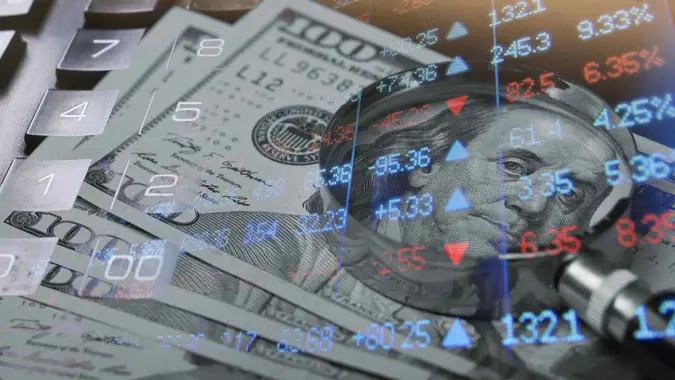Diamond Resale Value: How To Get the Best Price for Your Gem

Commitment to Our Readers
GOBankingRates' editorial team is committed to bringing you unbiased reviews and information. We use data-driven methodologies to evaluate financial products and services - our reviews and ratings are not influenced by advertisers. You can read more about our editorial guidelines and our products and services review methodology.

20 Years
Helping You Live Richer

Reviewed
by Experts

Trusted by
Millions of Readers
If you’re thinking of selling a diamond — or buying one and wondering if it will hold its value — you’re probably asking the right question: What is the diamond resale value and how can I get the best price for it?
Whether it’s a family heirloom, an engagement ring you no longer need or an investment you hope will pay off, understanding how diamond resale value works is essential for making a smart financial decision.
The truth? Most diamonds don’t resell for what you paid. But with the right knowledge and strategy, you can maximize your return.
Do Diamonds Increase in Value?
No, most diamonds don’t increase in value over time.
Despite their image as luxury assets, diamonds often depreciate by 30% to 70% once you walk out of the store. That’s because of high retail markups, fluctuating market demand and the lack of rarity in most standard diamonds.
Here’s why:
- Retail markups can be 100% or more, meaning you’re paying double or even triple the stone’s actual market value.
- Only rare or unique diamonds — like those with exceptional color or provenance — may appreciate over time.
- The global diamond market shrank by 20% in 2023, putting downward pressure on prices for mid-range stones.
In short, diamonds don’t typically perform like traditional investments and the resale market is rarely kind to average buyers.
How To Assess the Resale Value of Your Diamond
So, how do you know if your diamond has resale potential?
Start with the 4 Cs:
- Carat: Heavier diamonds tend to fetch higher prices.
- Cut: A high-quality cut boosts brilliance and desirability.
- Color: D-F colorless grades are the most valuable.
- Clarity: Fewer inclusions — imperfections — mean better resale potential.
Certification Is Critical
GIA-certified diamonds sell for 15 to 25% more on average than uncertified stones. A lab report from GIA, AGS or IGI builds buyer trust and proves your diamond’s authenticity.
The Diamond’s Condition
Chips, scratches and cloudiness can significantly lower resale value — even a small chip can reduce value by 10 to 20%. Keep your stone clean and stored safely.
Do Lab-Grown Diamonds Have Resale Value?
One of the most common questions today is: Do lab-grown diamonds have resale value?
Short answer: Not much.
| Factor | Natural Diamonds | Lab-Grown Diamonds |
|---|---|---|
| Initial Cost | Higher — due to rarity | Lower — manufactured in labs |
| Resale Value | Retains more resale value | Often loses up to 90% of the purchase price |
| Market Demand | Strong in the luxury and collector market | Still developing in resale channels |
| Rarity | Unique and limited | Not rare — easily reproduced |
| Long-Term Value | More likely to hold or gain value | Depreciates faster over time |
A 1-carat lab-grown diamond worth $2,000 at retail may only resell for $200 to $500, depending on quality and demand.
Does Every Diamond Have Resale Value?
Technically, yes — but not all are worth reselling.
Diamonds with low clarity, poor cut, no certification or outdated styles may have resale values under $100, especially for small or heavily included stones. Branding also matters: luxury brands like Tiffany & Co. may fetch a premium, even in resale.
Where you sell also impacts your return:
- Jewelry stores often offer the lowest value — wholesale or less.
- Online platforms like Worthy or eBay offer broader audiences, but expect seller fees.
- Auction houses work best for rare or high-value stones.
- Private buyers or consignment may net you more, but take time.
How To Sell Your Diamond for the Best Resale Value
Here’s how to increase your odds of a solid return:
1. Get It Appraised and Graded
Start with a professional appraisal and get it GIA-graded if it’s not already.
2. Clean It Professionally
A sparkling, well-presented diamond looks more valuable and desirable.
3. Pick the Right Channel
- Local jewelers for speed but lower prices
- Online consignment for better value
- Auction for high-value pieces with documentation
4. Have All Paperwork Ready
Original certificates, receipts and appraisals can boost resale offers by 10 to 20%.
Factors That Decrease Diamond Resale Value
- No lab certification
- Poor condition or visible flaws
- Fashion changes — like outdated cuts like marquise, heart, etc.
- Overpaying at the original purchase point
- The average retail markup on diamonds is 100% to 200%, making recouping costs difficult
The Impact of Trends on Diamond Resale Value
Like fashion, diamonds go in and out of style. And that affects your resale value.
- Round cuts hold their value best, while specialty shapes like cushion, pear or marquise fluctuate with trends.
- Vintage and minimalist designs are more in demand now than flashy settings.
- Sustainability is on the rise, but ethical sourcing doesn’t always guarantee higher resale value — yet.
Final Take to GO: What You Should Know About Diamond Resale Value
Selling a diamond can be emotional and financially confusing. Whether you’re trying to offload an engagement ring, cash out an inherited gem or just wondering “does diamond have resale value?”, the key is understanding what impacts its worth.
Most diamonds lose 30% to 70% of their original value, especially those without certification or tied to fashion trends. Lab-grown diamonds, while affordable upfront, typically offer little to no resale value in today’s market. To get the best return, focus on the 4 Cs, ensure your stone is GIA-certified and explore multiple selling platforms before making a decision.
Explore our guides on smart investing, asset selling and wealth protection to get the most out of what you own. Ready to turn your gem into cash? Check out our complete guide to selling jewelry for the best price or compare online jewelry buyers today.
FAQ
Here are the answers to some of the most frequently asked questions about diamond resale value and how it works:- What is the average resale value of a diamond?
- Most diamonds resell for 30% to 50% of their original retail value, depending on certification and condition.
- How can I increase my diamond's resale value?
- Clean it, get it graded and choose the right sales channel -- documentation helps too.
- Are diamonds a good investment for resale?
- Not typically. Most lose value after purchase unless they’re rare or brand-name.
- Can I sell my diamond back to the jeweler?
- Some offer trade-ins, but the offers tend to be lower than other resale channels.
- Do diamonds lose value over time?
- Yes, especially lab-grown or non-certified diamonds. Most depreciate immediately after purchase.
Data is accurate as of July 31, 2025, and is subject to change.
Our in-house research team and on-site financial experts work together to create content that’s accurate, impartial, and up to date. We fact-check every single statistic, quote and fact using trusted primary resources to make sure the information we provide is correct. You can learn more about GOBankingRates’ processes and standards in our editorial policy.
- The Guardian "Much depreciated: the goods that drop most in value"
- McKinsey & Company "The diamond industry is at an inflection point"
- The Week "The diamond market is losing its shine"
- Gemological Institute of America "What is a GIA Diamond?"
- jackieabraham.com "Understanding the Worth of Your Pre-Owned Jewelry"
 Written by
Written by  Edited by
Edited by 

























